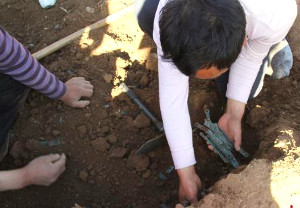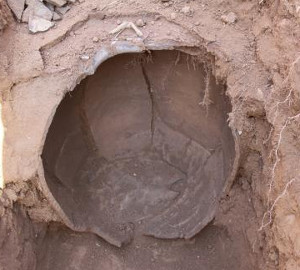A villager in Pingquan County (平泉县), Hebei Province (河北省) accidentally discovered a buried clay pot containing about 600 specimens of knife money from the Warring States Period (475 BC -221 BC), according to a dispatch from the China News (中新网) dated May 3, 2013.

Knife money from the ancient State of Yan being unearthed in Hebei
Mr. Wang Yongtie (王永铁), the village chief of Guangxingdian Village (广兴店村), explained that a resident of the village, Mr. Liu Jiafu (刘佳富), discovered the buried money while digging a ditch.
In the image at the left, some of the knives can be seen in the archaeologist’s left hand as he removes the artifacts from the clay pot.
Mr. Wang stated that this is the first time this type of cultural artifact has ever been discovered in the village.

The ming knives were discovered buried in this clay pot
About 600 knives were recovered according to Mr. Chang Wen (常文) who works at the Cultural Relics Protection Bureau of Pingquan County (平泉县问保所).
The knives all have a Chinese character inscribed on them which traditionally has been interpreted to be ming (明).
Although there are other interpretations for this character, this ancient form of money continues to be referred to as “ming knife money”.
Ming knife money was used by the State of Yan (燕国) during the Warring States Period.
Of the 600 specimens recovered, about 200 are complete and undamaged. The knives measure about 13.7 cm in length and 1.5 cm in width.
The knives were found in a clay pot buried approximately 2 meters below the surface.
For coverage of another recent discovery of buried knife money please see “Knife and Spade Money from State of Yan Unearthed in Hebei“.
